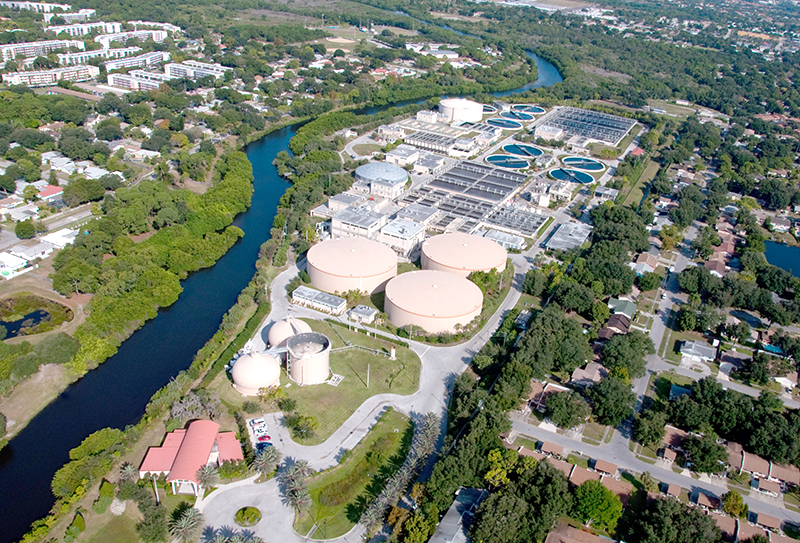WW-3
Require standardized monitoring and reporting of wastewater discharges
OBJECTIVES:
Require standardized monitoring and reporting of wastewater discharges to improve the accuracy and timeliness of pollutant loading estimates. Provide access to an up-to-date, publicly accessible database of industrial and domestic wastewater discharges. Develop and maintain an ongoing Tampa Bay-specific summary of information for loadings of core pollutants reported to the monitoring database.
STATUS:
Ongoing. Action revised to incorporate new information on improvements to reporting of wastewater discharges.
BACKGROUND:
Improved water quality has produced a resurgence of healthy seagrass meadows and associated fish and invertebrate communities in Tampa Bay. Protecting these gains requires diligent monitoring of pollutant inputs (loading) to the bay. The Tampa Bay Estuary Program (TBEP) regularly estimates loadings of core pollutants, including total nitrogen (TN), total phosphorus (TP), total suspended solids (TSS) and more recently, biochemical oxygen demand (BOD).

Pollutant loadings are estimated from a variety of sources, including atmospheric deposition, domestic and industrial point sources, groundwater, springs and nonpoint sources. Accuracy and timeliness of pollutant loading calculations is critical to development of loading estimates used by the Tampa Bay Nitrogen Management Consortium (NMC) to prepare Tampa Bay Reasonable Assurance (RA) documents. These data also are needed for Basin Management Action Plans (BMAPs) and other documents necessary to meet regulatory requirements and for tracking the long-term recovery of the bay (see Action WQ-1).
Although improvements to domestic and industrial wastewater treatment plants (WWTPs) have significantly reduced their water quality impact, they remain a small, but significant source of pollutant loading. In 2015, approximately 122 million gallons of treated wastewater were discharged into Tampa Bay per day. From 2011-2020, industrial and domestic wastewater discharges contributed an average of 5% and 12% of total nitrogen loading to Tampa Bay, respectively.
About a quarter of WWTPs in Florida are authorized to discharge treated wastewater (effluent) directly to surface waters under National Pollutant Discharge Elimination System (NPDES) permits. The remaining plants are authorized to discharge effluent to groundwater through land-application, beneficial use of reclaimed water or deep well injection (see Action WW-1). The Legislature passed a law in 2021 requiring domestic wastewater utilities that dispose of effluent, reclaimed water, or reuse water by surface water discharge to submit a plan for eliminating non-beneficial surface water discharge by January 1, 2032.
Wastewater treatment plants self-monitor and report their own discharges to the Florida Department of Environmental Protection (FDEP) through monthly or quarterly Discharge Monitoring Reports (DMRs), as required by their permits. All permitted facilities are required to monitor and report on the chemical composition of effluent discharges, but the specific parameters they monitor can vary from facility to facility, based on permit requirements. This is particularly problematic for estimating loadings from industrial WWTPs — their permits often require them to only report a subset of nutrient forms (e.g., ionized ammonia, orthophosphate), and often in a way (e.g., without concomitant flow data) that makes it difficult for resource managers to calculate accurate and timely loading estimates for core pollutants.
The Electronic Discharge Monitoring System (EzDMR) is an electronic reporting tool that saves time and reduces the potential for errors from manual entry of data. It provides instant access to a facility’s current reporting requirements, as well as the status and history of a facility’s reports.]
TBEP’s primary interest is consistent reporting of TN to accurately calculate loading estimates for the Reasonable Assurance process. Consistent reporting of TP, TSS and BOD as appropriate would also be helpful.
Another challenge to calculating accurate and timely pollutant loading estimates for WWTPs was that facilities traditionally could submit DMRs in hand-written or paper format. This required FDEP to enter data into databases by hand, which took time and could lead to data entry errors and significant lags in reporting data.
EPA recently promulgated E-reporting rule 80 FR 64063, which requires NPDES permitted facilities to electronically report and share data. This improvement will enhance transparency by providing a timelier, complete, more accurate and nationally consistent set of data in a more accessible form. As of December 2016, FDEP requires all NPDES wastewater and stormwater facilities to submit DMRs through their web-based Electronic Discharge Monitoring Report System (EzDMR). Compliance data from DMRs is accessible to the public through FDEP’s OCULUS website. Locally, the Environmental Protection Commission of Hillsborough County also maintains records of DMRs. ( )